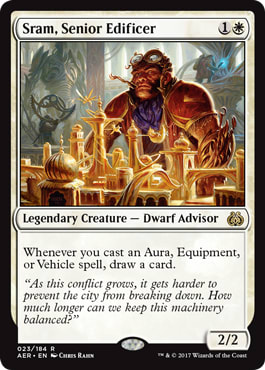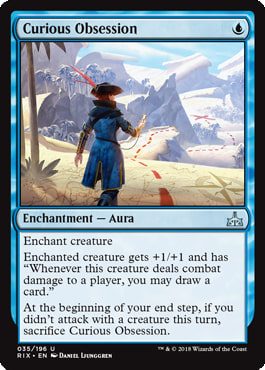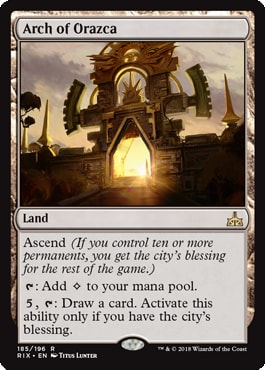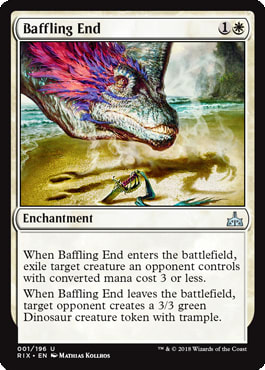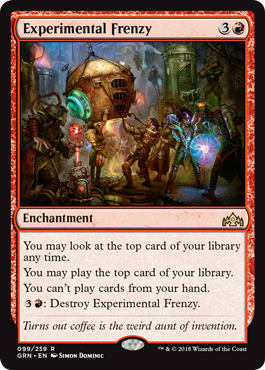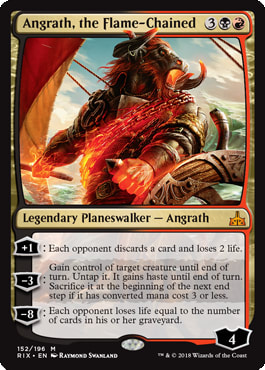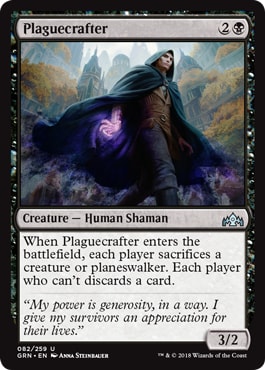There's no doubt that brewing is one of the most fun things in Magic.
Winning is awesome, but when your brew actually works and you get to win with your own creation there's not much better. The risk, of course, is that most brews don't work and you end up doing poorly and having to go back to the drawing board. And back again. And back again. Brewing is both hard and time-consuming! But, when it all works out... awesome.
2018 was a good year for me as far as brews go, and with the calendar looking to turn over to 2019 I thought it would be useful to take a look back at the lessons I learned from each brew.
Sram Auras | Standard | Jim Davis, 3rd Place SCG Classic Dallas
- Creatures (19)
- 3 Sacred Cat
- 4 Adanto Vanguard
- 4 Adorned Pouncer
- 4 Skymarcher Aspirant
- 4 Sram, Senior Edificer
- Instants (2)
- 2 Sheltering Light
- Enchantments (19)
- 1 Trial of Solidarity
- 3 Baffling End
- 3 Legion's Landing
- 4 Cartouche of Knowledge
- 4 Cartouche of Solidarity
- 4 Curious Obsession
- Lands (20)
- 4 Island
- 7 Plains
- 2 Shefet Dunes
- 3 Irrigated Farmland
- 4 Glacial Fortress
- Sideboard (15)
- 1 Baffling End
- 2 Squire's Devotion
- 1 Dive Down
- 2 Slash of Talons
- 2 Fragmentize
- 2 Authority of the Consuls
- 2 Spell Pierce
- 3 Negate
Deck: Sram Auras
We started the year with a brewing bang with ![]()
![]() Sram Auras, an ultra fun and competitive aggressive
Sram Auras, an ultra fun and competitive aggressive ![]()
![]() deck that utilized Sram, Senior Edificer and Curious Obsession as card draw engines built into an aggressive shell. The deck was also one of the first decks to make good use of Adanto Vanguard, now considered to be one of the best 2-drops in the format. I played the deck a bunch of stream, while also taking it to 3rd place of the SCG Classic at SCG Dallas - cue the good feelings for doing well with your own brew.
deck that utilized Sram, Senior Edificer and Curious Obsession as card draw engines built into an aggressive shell. The deck was also one of the first decks to make good use of Adanto Vanguard, now considered to be one of the best 2-drops in the format. I played the deck a bunch of stream, while also taking it to 3rd place of the SCG Classic at SCG Dallas - cue the good feelings for doing well with your own brew.
However, the deck almost never was.

The deck started here, and like many half-baked deck ideas it almost died here as well. I had been brewing up decks for my stream and liked the idea of Sram, Senior Edificer with the Cartouches from Amonkhet alongside the indestructible and then underrated Adanto Vanguard. The problem was there just weren't enough cards for the deck. I hit this point, which was only 31 spells, and gave up. Thankfully I didn't delete the unfinished deck file however, because Rivals of Ixalan was right around the corner.
Curious Obsession was everything the deck could have ever wanted. As anyone who's played with or against Mono-Blue Aggro will tell you Curious Obsession is a house, and it drawing a card off of Sram or being unstoppable on an Adanto Vanguard was perfect. Skymarcher Aspirant also gave the deck another very solid 1-drop as the deck was capable of getting the city's blessing very quickly.
Lesson Learned: Don't Throw Out Your Ideas
Just because an idea wasn't there yet doesn't mean it can't get there! Even if your idea didn't work initially, it may be one new set or one metagame shift away from relevance. Keep those half-completed ideas at the ready, especially when a new set comes out, as you may just have something you're looking for right under your nose.
Bant Approach | Standard | Jim Davis
- Instants (5)
- 2 Essence Scatter
- 3 Settle the Wreckage
- Sorceries (15)
- 3 Fumigate
- 4 Approach of the Second Sun
- 4 Hour of Promise
- 4 Spring // Mind
- Enchantments (12)
- 2 Cast Out
- 2 Gift of Paradise
- 2 Search for Azcanta
- 3 Baffling End
- 3 Ixalan's Binding
- Artifacts (3)
- 3 Thaumatic Compass
- Lands (25)
- 1 Island
- 2 Forest
- 2 Plains
- 1 Arch of Orazca
- 1 Hashep Oasis
- 1 Scavenger Grounds
- 1 Shefet Dunes
- 2 Desert of the Indomitable
- 3 Botanical Sanctum
- 3 Sunpetal Grove
- 4 Ipnu Rivulet
- 4 Irrigated Farmland
- Sideboard (15)
- 1 Baffling End
- 2 Carnage Tyrant
- 2 Jace's Defeat
- 2 Desert's Hold
- 4 Regal Caracal
- 1 Fragmentize
- 3 Negate
Deck: Bant Approach
Man Rivals of Ixalan was fun, wasn't it?
While it didn't provide any of the fundamental pieces to the deck (Hour of Promise, Spring // Mind, Approach of the Second Sun), Rivals of Ixalan did give the deck an important piece of early removal as well as what would become part of the decks key engine, Arch of Orazca. With Hour of Promise giving you access to your one Arch of Orazca every game and its zombie tokens giving instant city's blessing, Bant Approach now had a powerful engine and way to win the game that didn't involved creatures or planeswalkers at all.
Why was this so important?
Because busted creatures were the name of the game in Standard at the time.
Cards like Rekindling Phoenix and The Scarab God required fast and specific answers or they would take over the game very quickly, while pretty much every deck was looking to win the game with some assortment of high quality creatures. This made cards like Vraska's Contempt, Fatal Push, and friends absolute necessities. So it stands to reason that if you could build a deck that didn't need creatures or planeswalkers you'd be in pretty good shape.
Lesson Learned: Take The Path Of Least Resistance
Bant Approach was a byproduct of circumventing the format in a unique way. You left your opponent with a ton of dead cards and came at them from an angle they weren't prepared for. Once your opponent got to sideboard in things Duress and Negate for all that creature removal, you'd just bring in Carnage Tyrant and take 'em to school.
Finding the holes in the format can be tough, but it also can pay off big. We've seen this recently with Bant Turbofog and we will see it again.
Dunkin' Dinos | Guilds Standard | Jim Davis
- Creatures (12)
- 4 Dryad Greenseeker
- 4 Llanowar Elves
- 4 Wayward Swordtooth
- Planeswalkers (2)
- 2 Karn, Scion of Urza
- Instants (7)
- 3 Shock
- 4 Lightning Strike
- Sorceries (7)
- 2 Banefire
- 2 Lava Coil
- 3 Fight with Fire
- Enchantments (4)
- 4 Experimental Frenzy
- Artifacts (4)
- 4 Treasure Map
- Lands (24)
- 11 Forest
- 7 Mountain
- 2 Field of Ruin
- 4 Rootbound Crag
- Sideboard (15)
- 1 Banefire
- 1 Lava Coil
- 2 Crushing Canopy
- 2 Thrashing Brontodon
- 3 Deathgorge Scavenger
- 4 Fiery Cannonade
- 2 Sorcerous Spyglass
Deck: Dunkin Dinos
Speaking of fun...
...Dunkin Dinos was it!
While it ended up being pretty soft to Golgari Midrange and their Vivian Reids and Carnage Tyrants, Dunkin Dinos was a super fun deck looking to take Experimental Frenzy to its absolute limits.
Rather than just play Experimental Frenzy and hope to hit a string of good cards each turn, Dunkin Dinos went all out with cards like Treasure Map, Dryad Greenseeker, and Wayward Swordtooth as ways to break Experimental Frenzy's limitations. When the deck had its pieces in play it would tear through a half a dozen cards each turn until it eventually finished the game with a huge Banefire or kicked Fight With Fire.
The deck likely too the theme too far, but in doing so it was successful in finding out how much synergy you wanted with your Experimental Frenzies.
Lesson Learned: Taking A Card To Its Extreme Finds The Sweet Spot
When working with a new and exciting card, it's often best to take it to its absolute extreme and see what happens. It won't usually be the "proper" way to use the card in the end, but once you've seen how the extreme reacts you can use the information and dial back appropriately.
Rakdos Midrange | Guilds Standard | Jim Davis, 36th Place SCG Invitational
- Creatures (24)
- 1 Dire Fleet Daredevil
- 1 Goblin Instigator
- 2 Ravenous Chupacabra
- 4 Dusk Legion Zealot
- 4 Midnight Reaper
- 4 Plaguecrafter
- 4 Rekindling Phoenix
- 4 Siege-Gang Commander
- Planeswalkers (3)
- 3 Angrath, the Flame-Chained
- Instants (3)
- 3 Vraska's Contempt
- Sorceries (4)
- 4 Lava Coil
- Enchantments (1)
- 1 Arguel's Blood Fast
- Lands (25)
- 7 Swamp
- 8 Mountain
- 2 Memorial to Folly
- 4 Cinder Barrens
- 4 Dragonskull Summit
Deck: Rakdos Midrange
Back to the present.
I'm not going to spend a ton of time talking about Rakdos Midrange because I just wrote an article about how I played the deck to a good finish at the SCG Inviational, but I do think there's an important lesson to be learned about the brew.
Going into the Invitational, the three top decks in the format were Golgari Midrange, ![]()
![]() Drakes (with Dive Down and no Arclight Phoenix), and Jeskai Control (with Niv-Mizzet, Parun). As such, the format's premier threats were Carnage Tyrant, a drake backed up with Dive Down, or a Niv-Mizzet, Parun. Do you know what card is solid overall and really good against all of these things?
Drakes (with Dive Down and no Arclight Phoenix), and Jeskai Control (with Niv-Mizzet, Parun). As such, the format's premier threats were Carnage Tyrant, a drake backed up with Dive Down, or a Niv-Mizzet, Parun. Do you know what card is solid overall and really good against all of these things?
Nice Dive Down.
The other important part of the format was great exiling removal (Lava Coil and Vraska's Contempt) and durable threats that need to be exiled to avoid losing value (Midnight Reaper and Rekindling Phoenix). Normally decks have a maximum of four of these threats, as well as four cards that answer them, By playing both Red and Black, we get the full bevy of awesome threats and answers. Which leads us to our last lesson...
Lesson Learned: Find What A Format Is About And Exploit It
Rakdos Midrange did an excellent job at exploiting the holes in that format.
Because we don't have actual Rakdos cards yet or Blood Crypt, the overall power level of the deck is a little low, but it did such a good job against the three main decks that it was more than acceptable. The problem with this is when you end up playing against decks you don't expect, which makes Rakdos Midrange a weaker choice in an open metagame, but a lot of deck-building is focused or tailored for one tournament or one metagame.
It's not about the best tool; it's about the right tool.
Transferable Skills
Magic is always changing.
The deck you build or learn now will be obsolete in six months, so it's important to go beyond the small picture and make sure you are taking with you the things you are learning from each deck you work on and practice with. By being able to transfer big picture skills from each deck-building experience, you're going to find it much easier to solve future deck-building issues and make quality metagame assessments.
So when a new set comes out, a format rotates, or the metagame shifts, don't throw away everything you've learned when you move to a new deck!
















